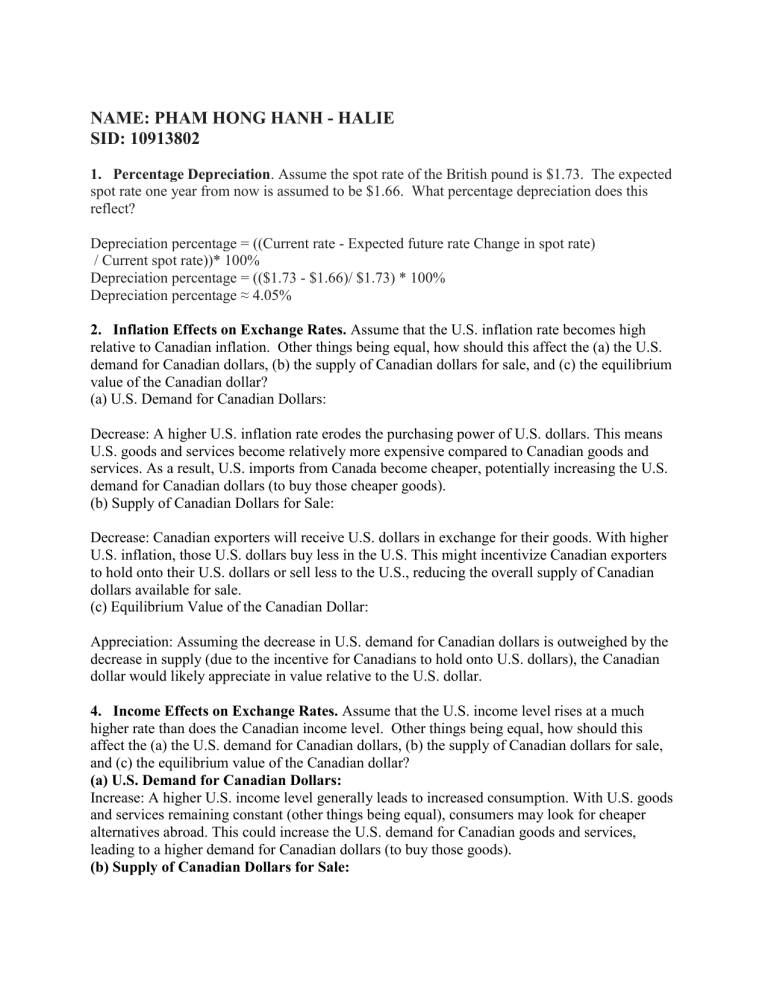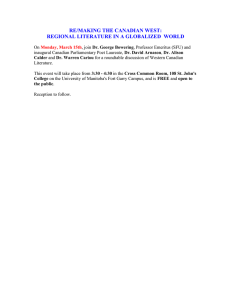
NAME: PHAM HONG HANH - HALIE SID: 10913802 1. Percentage Depreciation. Assume the spot rate of the British pound is $1.73. The expected spot rate one year from now is assumed to be $1.66. What percentage depreciation does this reflect? Depreciation percentage = ((Current rate - Expected future rate Change in spot rate) / Current spot rate))* 100% Depreciation percentage = (($1.73 - $1.66)/ $1.73) * 100% Depreciation percentage ≈ 4.05% 2. Inflation Effects on Exchange Rates. Assume that the U.S. inflation rate becomes high relative to Canadian inflation. Other things being equal, how should this affect the (a) the U.S. demand for Canadian dollars, (b) the supply of Canadian dollars for sale, and (c) the equilibrium value of the Canadian dollar? (a) U.S. Demand for Canadian Dollars: Decrease: A higher U.S. inflation rate erodes the purchasing power of U.S. dollars. This means U.S. goods and services become relatively more expensive compared to Canadian goods and services. As a result, U.S. imports from Canada become cheaper, potentially increasing the U.S. demand for Canadian dollars (to buy those cheaper goods). (b) Supply of Canadian Dollars for Sale: Decrease: Canadian exporters will receive U.S. dollars in exchange for their goods. With higher U.S. inflation, those U.S. dollars buy less in the U.S. This might incentivize Canadian exporters to hold onto their U.S. dollars or sell less to the U.S., reducing the overall supply of Canadian dollars available for sale. (c) Equilibrium Value of the Canadian Dollar: Appreciation: Assuming the decrease in U.S. demand for Canadian dollars is outweighed by the decrease in supply (due to the incentive for Canadians to hold onto U.S. dollars), the Canadian dollar would likely appreciate in value relative to the U.S. dollar. 4. Income Effects on Exchange Rates. Assume that the U.S. income level rises at a much higher rate than does the Canadian income level. Other things being equal, how should this affect the (a) the U.S. demand for Canadian dollars, (b) the supply of Canadian dollars for sale, and (c) the equilibrium value of the Canadian dollar? (a) U.S. Demand for Canadian Dollars: Increase: A higher U.S. income level generally leads to increased consumption. With U.S. goods and services remaining constant (other things being equal), consumers may look for cheaper alternatives abroad. This could increase the U.S. demand for Canadian goods and services, leading to a higher demand for Canadian dollars (to buy those goods). (b) Supply of Canadian Dollars for Sale: No significant change (assumed): In this scenario, we assume the Canadian income level doesn't rise much. Therefore, there's no significant incentive for Canadians to change their spending habits or sell more goods and services abroad. The supply of Canadian dollars for sale might remain relatively stable. (c) Equilibrium Value of the Canadian Dollar: Appreciation: Assuming the increase in U.S. demand for Canadian dollars outweighs the stable supply, the Canadian dollar would likely appreciate in value relative to the U.S. dollar. 21. Speculation Exchange Rate Gain: If the SGD depreciates to $0.42 as expected, Diamond Bank will gain from selling the USD back at the higher exchange rate. Profit from Exchange Rate (per USD): $0.43 (initial rate) - $0.42 (expected future rate) = $0.01 per USD Interest Rate Differential: Diamond Bank can potentially benefit from the difference in borrowing and lending rates between SGD and USD. Interest Rate Gain (for borrowing SGD): Borrowing rate (USD) - Borrowing rate (SGD) = 7.2% - 24.0% = -16.8% (negative since borrowing SGD incurs a cost) Interest Rate Gain (for lending USD): Lending rate (USD) - Borrowing rate (USD) = 7.0% 7.2% = -0.2% (negative since borrowing USD also incurs a cost) 27. Volatility of Exchange Rate Movements. Mean Monthly Rate = (0.4602 + 0.4709 + 0.4888 + 0.4406 + 0.4260) / 5 Mean Monthly Rate = 0.4573 Squared Deviations from the Mean for Each Month: May: (0.4602 - 0.4573) ^ 2 ≈ 0.000729 June: (0.4709 - 0.4573) ^ 2 ≈ 0.017424 July: (0.4888 - 0.4573) ^ 2 ≈ 0.099049 August: (0.4406 - 0.4573) ^ 2 ≈ 0.027025 September: (0.4260 - 0.4573) ^ 2 ≈ 0.096049 Variance = [(0.000729) + (0.017424) + (0.099049) + (0.027025) + (0.096049)] / (5 - 1) Variance = 0.240276 / 4 Variance ≈ 0.060069 Standard Deviation = √(0.060069) Standard Deviation ≈ 0.2450



